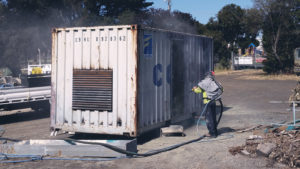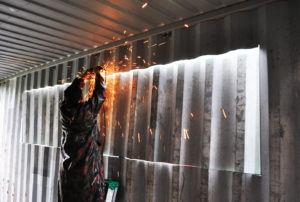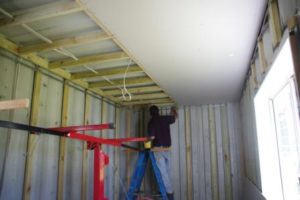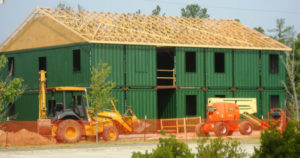Shipping Container Livin’
There’s a global shipping container cargotecture home-hype happening all over the world, but is the shipping container that is used as a building block for a home really the environmental-saving, cost-effective, time-saving be-all and end-all construction material we’re led to believe?
The key to building successfully with shipping containers is knowing the shipping container’s benefits and its limitations. Shipping containers were, after all, built for transport at sea, not for living in. Then again, responsible, eco-friendly repurposing is a good thing, right?
Let’s take a look at some of the common beliefs and myths about building with shipping containers.
Myth: Most unused, use-by-date shipping containers sit in ports around the world, abandoned, accumulating in the hundreds of thousands, an eye-sore in our environment. Building with shipping containers is the eco-friendly choice. It is believed that repurposing or recycling these industrial left-overs, converting them into houses, is a sustainable and environmentally friendly activity, more so than traditional residential construction using common materials such as wood.
 Fact: Many people do repurpose shipping containers for a home, and do live quite contently within them; however, new shipping containers are also being bought for conversion into homes. There is the obvious cost differential with used shipping containers being sold at a fraction of the price of a new one. Old containers have obvious defects and almost always one will not know what was stored in it over the life of that container. Some shipping containers may have been exposed to toxins that, knowingly or unknowingly, had leaked from seemingly-safe packaging. On the other hand, new shipping containers are clean, uncontaminated and dent-free, and without question or structural examination, one can safely expect that they would be structurally safe. Some container home builders say they only use brand new containers for one important reason, and that is safety.
Fact: Many people do repurpose shipping containers for a home, and do live quite contently within them; however, new shipping containers are also being bought for conversion into homes. There is the obvious cost differential with used shipping containers being sold at a fraction of the price of a new one. Old containers have obvious defects and almost always one will not know what was stored in it over the life of that container. Some shipping containers may have been exposed to toxins that, knowingly or unknowingly, had leaked from seemingly-safe packaging. On the other hand, new shipping containers are clean, uncontaminated and dent-free, and without question or structural examination, one can safely expect that they would be structurally safe. Some container home builders say they only use brand new containers for one important reason, and that is safety.
 Here are a few additional considerations when contemplating the use of a used shipping container. Before a shipping container can become habitable, it is highly recommended that the entire container is sandblasted bare, and its flooring replaced, to remove any harmful chemicals that might be present from its initial construction. Often the coatings used to make the containers durable for ocean transport contain a number of harmful chemicals. Wooden floors in shipping containers are also infused with hazardous chemical pesticides. The use of these chemicals on or in the shipping container may cause health complications.
Here are a few additional considerations when contemplating the use of a used shipping container. Before a shipping container can become habitable, it is highly recommended that the entire container is sandblasted bare, and its flooring replaced, to remove any harmful chemicals that might be present from its initial construction. Often the coatings used to make the containers durable for ocean transport contain a number of harmful chemicals. Wooden floors in shipping containers are also infused with hazardous chemical pesticides. The use of these chemicals on or in the shipping container may cause health complications.
 The openings cut for windows and doors are usually cut with a torch or fireman’s saw, multi-containers are usually welded together and reinforcing steel and additional welding required. There are carbon emissions associated with transport, setup, and shipping container construction. Fossil fuels required to move the container from port to acreage using heavy machinery will contribute to a significant ecological footprint. This footprint should be compared to traditional home construction.
The openings cut for windows and doors are usually cut with a torch or fireman’s saw, multi-containers are usually welded together and reinforcing steel and additional welding required. There are carbon emissions associated with transport, setup, and shipping container construction. Fossil fuels required to move the container from port to acreage using heavy machinery will contribute to a significant ecological footprint. This footprint should be compared to traditional home construction.
 If one is thinking to install and hang internal panelling on stud walls stuffed with insulation, then inevitably the use of these materials, not often eco-friendly, should also be considered vs. eco-friendly products such as wood from sustainable forests, wool insulation, etc.
If one is thinking to install and hang internal panelling on stud walls stuffed with insulation, then inevitably the use of these materials, not often eco-friendly, should also be considered vs. eco-friendly products such as wood from sustainable forests, wool insulation, etc.
Conclusion: If you are serious about building a home using a repurposed shipping container for the sake of being eco-friendly, then it is advised to speak with a reputable shipping container supplier about sourcing a structurally sound, clean used container rather than buying a new one. You’ll save heaps. Used containers are available in varying conditions and are usually graded. In fact, many have only been used once. It would be wise to research insulation methods extensively keeping your climate in mind, and use natural materials where possible.
Speed and Ease of Construction
Myth: Building with shipping containers is much faster than traditional construction, cheaper, and is so easy almost anyone can do it.
 Fact: The benefit of small shipping container homes is that once they are delivered, they can be modified and construction completed relatively quickly. Prefabrication can be conducted either on-site or off.
Fact: The benefit of small shipping container homes is that once they are delivered, they can be modified and construction completed relatively quickly. Prefabrication can be conducted either on-site or off.
A small home can be prefabricated in as little as three weeks. Final touches can then be wrapped up in no-time-at-all making on-site final retrofitting a cost-effective, quick process.
It may also be true that constructing a shipping container home is more achievable by an avid DIY’er than traditional residential construction. You also have the option of contracting a shipping container design firm to lessen the burden.
Do keep in mind the need for building permits. Since using shipping containers to build a home is a relatively new idea, it may be hard to obtain the necessary building permits from your local council.
Conclusion: Depending on your experience, it is possible to build a container home primarily on your own, and quickly. Even for the inexperienced, contractors can be hired to assist in completing your build in a speedy manner. Just make sure you get started on obtaining the right permits and approvals early to avoid delays.
The trend in building with shipping containers is a relatively new approach to architecture and construction, but their inherent flaws and limitations should not be ignored. Do your homework prior to commitment.
